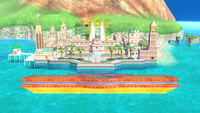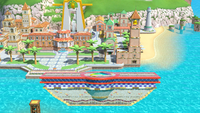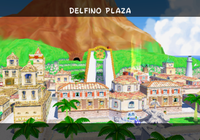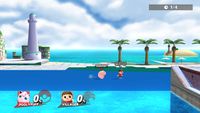Delfino Plaza: Difference between revisions
No edit summary |
Worldblender (talk | contribs) No edit summary |
||
| Line 63: | Line 63: | ||
===Ω form=== | ===Ω form=== | ||
The Ω form uses the base platform with an extra bottom layer. Like many touring stages, the stage does not stop at any places of interest. Star KOs are enabled. | The Ω form uses the base platform with an extra bottom layer. Like many touring stages, the stage does not stop at any places of interest. Star KOs are enabled. | ||
In ''Super Smash Bros. Ultimate'', the main platform of the [[Ω form]] is similar to ''SSB4'''s Ω form; however, it is resized and reshaped to match {{SSBU|Final Destination}}. | |||
<gallery widths="200px"> | <gallery widths="200px"> | ||
SSB4UDelfinoPlazaOmega.jpg| | SSB4UDelfinoPlazaOmega.jpg|Ω form in ''Super Smash Bros. for Wii U''. | ||
File:SSBU-Delfino_PlazaOmega.png|Ω form in ''Super Smash Bros. Ultimate''. | |||
</gallery> | </gallery> | ||
Revision as of 03:21, November 28, 2018
| Delfino Plaza | |
|---|---|
 Delfino Plaza in Super Smash Bros. Ultimate. 
| |
| Universe | Mario |
| Appears in | Brawl SSB4 (Wii U) Ultimate |
| Availability | Starter |
| Crate type | Normal |
| Maximum players | 4 (Brawl and Wii U) 8 (Wii U Ω form, Ultimate) |
| Tracks available | In Brawl: Delfino Plaza Title / Ending (Super Mario World) Main Theme (New Super Mario Bros.) Ricco Harbor Main Theme (Super Mario 64) In SSB4: Delfino Plaza Ricco Harbor Super Mario 3D Land Theme / Beach Theme Princess Peach's Castle Rainbow Cruise Main Theme (New Super Mario Bros.) Main Theme (Super Mario 64) Bolded tracks must be unlocked |
| Article on Super Mario Wiki | Delfino Plaza |
Delfino Plaza (ドルピックタウン, Dolphic Town) is a stage in Super Smash Bros. Brawl based on the 2002 game Super Mario Sunshine released for Nintendo GameCube. It returns as a familiar stage in Super Smash Bros. for Wii U and Super Smash Bros. Ultimate. Players battle on a floating platform, which then drops the characters off at a certain location before picking them up again and transporting them to another location, essentially touring them around the area. In Super Smash Bros. for Wii U, Dr. Mario is fought here for his unlocking battle.
Stage overview
The battle begins on a main platform that uses propeller-propulsion with two small transparent platforms above it and another large arching transparent platform above them. However, the arrangement of the platforms on changes each time the main platform picks characters up to move them to a different location. The formats are:
- The starting arrangement of platforms described above.
- The large main platform with three small platforms above it; one high up in the center and two lower ones to the left and right of the ledges.
- The large main platform with two small platforms above it; one on the left and the other, slightly higher, on the right.
- The large main platform with three small platforms above it; one high up in the middle and the other two lower, slanting diagonally down towards the stage from the left and right respectively.
The stage hovers toward Isle Delfino, which resides in the background and drops players off at numerous landmarks around the island. All of these variants make Delfino Plaza the stage with the most individual fighting arenas in Brawl. The locales are landed on in a random order and they are as follows:
- The small, dune-shaped island to the east of a plaza. A warp pipe and a palm tree sit in the background here.
- The second, slightly larger island on the far western area of the main plaza. Both islands are surrounded by the ocean which can be swam in.
- The three grass-covered stone spires near the shoreline. Players can swim in the sea between the spires and also on the edges.
- The row of buildings in front of the Shine Gate.
- The Shine Gate. Two platforms have been attached to either side.
- The walkway at the front of the main courtyard. The Pianta statue is absent from its usual spot.
- The area in front of the dolphin fountain with a staircase on both sides.
- The area with a line of beach umbrellas to the left of the Shine Gate.
- The two areas on the western edge of the island. A shallow veranda sits in between, which characters can walk around in, and a deeper section that requires swimming to navigate.
Differences from Super Mario Sunshine
- The city's size has been decreased, proved by comparing with characters in Brawl and in Super Mario Sunshine.
- The manholes are not the same as they appear in Super Mario Sunshine.
- The Grand Pianta Statue does not appear on the background of the stage.
- Additionally, the boxes containing the three variations of F.L.U.D.D. nozzles are also no longer in the background.
- The cannon that transported Mario to Pinna Park is no longer there.
- The Shine Gate has two platforms at each side that were not there in Super Mario Sunshine.
- The large Shine Sprite on the Shine Gate spins in Super Smash Bros. Brawl, but it doesn't in Super Mario Sunshine. The only time it ever spins is when it's cleaned for the first time, and when sprayed. After it is cleaned, it stays still permanently.
- There is a platform on one section of the level that is in the water, and originally wasn't there in Sunshine.
- On the front of the plaza (one of the sections where one can battle), the ledges were rounded in Sunshine, but were made rectangular to fight on in Brawl.
- The pipe on top of both the Shine Gate that led to Pianta Village and the building in front of it which led to Sirena Beach are no longer there.
- Although the mosaic in front of the dolphin statue is still there, the giant beam of sunlight that teleported Mario to Noki Bay is missing.
- The paint portals on the pier hut (leading to Ricco Harbor) and the lighthouse (leading to Gelato Beach) have both been removed in Brawl.
- All of the Yoshi eggs that used to be in the Plaza have been taken out.
- The umbrellas in Delfino Plaza have no bouncing properties, unlike in Sunshine.
- Although it's normally a busy plaza, not one Pianta is seen in the level.
- The water in many parts of the stage is shallower than in Super Mario Sunshine.
- The Pipe on the small island that leads to the poisonous river stage no longer has the yellow zigzag-damaging substance.
- The boats are different as they are lacking the umbrellas.
Ω form
The Ω form uses the base platform with an extra bottom layer. Like many touring stages, the stage does not stop at any places of interest. Star KOs are enabled.
In Super Smash Bros. Ultimate, the main platform of the Ω form is similar to SSB4's Ω form; however, it is resized and reshaped to match Final Destination.
Origin
This stage is based on Delfino Plaza from Super Mario Sunshine. It is the largest city on Isle Delfino, and it acts as the hub area for the game as all seven levels are accessed from there in various ways.
Some areas Mario visits include, Ricco Harbor, a commercial fishing area and the music for which is used in Brawl and Smash 4; Pinna Park, an amusement park built on an island that Mario could only access by being shot from a cannon; Delfino Airstrip, a small airport built on three islands where Mario and co. arrived to Isle Delfino and that can be visited again after defeating Bowser; and an active volcano named Corona Mountain, where the final boss fight against Bowser takes place. All these locations could be seen from a distance from Delfino Plaza and are retained in the far background of this stage.
In Super Mario Sunshine, Mario, Toadsworth, a group of Toads, and Princess Peach flew to the island for a vacation. Upon arrival, the entire island was covered in graffiti and goop by Bowser Jr. disguised as Mario. Mario was blamed for the situation and was sentenced to clean up Isle Delfino with the help of F.L.U.D.D. Due to heavy reuse of the Super Mario Sunshine models, this stage is very close to how it is presented in Super Mario Sunshine, with the primary difference being that the whole area is scaled down.
Tournament legality
In Brawl
This stage is usually a counterpick, as while the stage is fairly unintrusive, the ability to shark on the main hovering platform, and some parts of the stage having walls and walk-offs, give a fairly large advantage to certain characters (most infamously Meta Knight and King Dedede).
While usually legal, this stage is often banned in stage conservative rulesets, such as the Japanese ruleset. The aforementioned reasons for why it's a counterpick are seen as too much for a legal stage by those with a conservative mindset. Such players also usually see Meta Knight as too powerful on the stage, thus use the rationale that they must ban the stage to prevent Meta Knight players from getting a "free win" on their counterpick.
In Smash 4
Delfino Plaza was once again legal as a counterpick in the early stages of the Smash 4 metagame. However, as many characters were able to KO early on the top blast line, which drastically shifts downward during the transitions, it was seen as too powerful for characters with great vertical KO moves (such as Donkey Kong or R.O.B.) and against particularly floaty or light characters (such as Jigglypuff or Rosalina, who would also benefit from the blast line shift due to Luma's strong up aerial). Since Smash 4's release, there have been more stages to choose from over Delfino Plaza (such as Dream Land), and it has been banned in major rulesets as of GENESIS 3.
Glitches
- If a player uses a "Multi-Kick" attack (such as Peach's down aerial) while the platform is landing at the beach island, the player can fall through it and end up swimming underneath.
- If the stage is reset - either by restarting in Training Mode or via Sudden Death - as the platform comes to rest in certain locations in the town, the models for some buildings, centerpieces, or even interactable objects and floors will not be visible, and will remain invisible until the locations are visited again. This occurs because in some locations of the stage, when there is no way of viewing these buildings with the camera, the game will temporarily stop rendering them to reduce potential game lag. However, resetting the stage skips the cue for the buildings to be made visible again, causing the glitch. It can be seen in action here.
Update history
- Added 8-player mode version of the stage's Ω form.
Gallery
Super Smash Bros. Brawl
Captain Falcon standing on one of the islands.
Super Smash Bros. for Wii U
Delfino Plaza in Super Smash Bros. for Wii U.
Luigi and Donkey Kong battling on Delfino Plaza.
Super Smash Bros. Ultimate
Trivia
- The propelled platforms have F.L.U.D.D.'s propeller on them.
- At the stone spires, Pokémon Trainer can be seen far in the background on the grass part at the volcano's foot if he is selected.
- If R.O.B. is met in Classic or All-Star but the player has not unlocked the Mario Bros. stage, he is fought on Delfino Plaza.
- In the beta version of Brawl, the music track "Castle/Boss Fortress (Super Mario World/SMB 3)" was one of the tracks in Delfino Plaza's My Music selection (as shown in a screenshot on the Smash Bros. DOJO!! website). For the final version of Brawl, though, the track was moved to Luigi's Mansion.
- By using a hacked camera, one can see that only half of Corona Mountain is part of the stage. Also, in Brawl, areas inside buildings and under manhole covers are surprisingly detailed when using a hacked camera, suggesting that the model was taken directly out of Super Mario Sunshine.[1]
References
External links
















